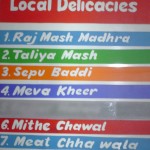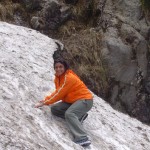
“Jyoti Thakur is the man!”, we were told,emphatically, when we were starting our planning phase to visit the Himachal. Our cousins Paplu & Debbie were stationed at a beautiful bungalow in Jammu,back then. Paplu is in the armed forces in India, and serves a rank that is senior enough and consequently enabling him to have the ‘good-life’, so to say! Passionate about taking to flight himself, Paplu almost immediately suggested that Jyoti was a one-man-shop-and-stop for any visitor in Himachal. And that, he has been ‘tried-and-tested’ by themselves as well. A flying instructor by profession,he was the certified guide we would be using for this trip. After a short base-camp visit to Paplu and Debbie’s palatial and gorgeous bungalow,in Jammu, we decided to head to Dalhousie in an overnight bus, one April evening. And as luck would have had it, the bus ran 10 hours late, and we reach Dalhousie at the designated bus-stop, in pitch mountain darkness.
No one in sight. An eerie blackness with the night mist from the mountain citadels enveloping us slowly,we wait for our ‘night’ in shining armour to receive us. In our imagination, we start thinking of Jyoti as this mustached custodian of the flying force, with if not any larger, but definitely a hummer in which he will take us around to savour the local feel of Himachal. A pair of headlights makes and grunts its way to our destination, making our hopes dance in joy! Jyoti has finally arrived. What stops in front of us in a puny white Maruti Suzuki 800 car, and from inside it, out it fetches a 5ft5inch high boyish person in brown canvases and cords and a colourful kullu-topi. Stereotyped Expectations, say hello to Jyoti!
“Jyoti, we are hungry! “, I squirm almost in agony. “Oh, no problem Madamji. Me takes you Sud’s restaurant, just 10-12 minutes from here”. Off we speed in the little white car to Sud’s. A menu-board dangled precariously at the door, displaying local food. “What cuisine do the people have here?”, I ask Sud politely. “Oh, nothing!” Mr Sud waves his right hand dismissively. “Anyway it is too cold for anything to grow here. Isn’t that so?” He looks for confirmation at his headwaiter, who nods gravely. He looks at Jyoti, rethinks on what he just said and continues. “But let me serve you phamra. It really isn’t the time of the day to have this, but I think you will like it”. It’s a breakfast dish, apparently, involving a small-grained local dal called baat, a red millet called sil, and a leafy vegetable called sukhi saag, which grows in sub-zero temperatures, all simmered together for several hours. Just when we’re beginning to get our hopes up, though, he brings the topic unceremoniously to a close. “But nowadays you won’t find it anywhere. Not in town, anyway. The locals think that’s peasant food.” The old restaurant owner quakes with silent laughter. “They all eat tourist food now!”
The next morning, after a very early check out, we head for Chamba.
Half the fun of a trip to Chamba is getting there. From Dalhousie, via the Khajjiar Valley, the road over Chowari Pass through the village of Jot rises 8,000 feet above sea level, and the views are stunning. The one-lane road winds through the outer Himalayas where you can see snow-covered peaks, hillsides lined with terraces of corn and rice, and the Gaddis, the tribal folks, herding goats, and the occasional Indian fox.
And then, suddenly there was a sudden bout of the summer rain. Rain in the mountains, is an amazing spectacle to behold! Arriving as we did in dusk and monsoon, our ride from Jot to Chamba was as thrilling as a roller coaster, descending in loud honks and flashing headlights before every hairpin turn and sliding around slopes that dropped into great voids of fog and valleys. Twists and turns lead us to Chamba along a scenic road which hugs Ravi River.
When we arrived, bursting around another narrow bend and encountering a small plateau sparkling with the lights of tightly packed homes, we realized why this community has remained untouched by the ravages of war for more than a thousand years. Peace had been preserved by the mountains. Even the powerful Mughals never invaded. Legend has it that in the 17th century, Raja Chatter Singh of Chamba was ordered to tear the temples down, but instead he crowned them with gilded pinnacles—and no one marched over the mountains to challenge him.
Mornings in Chamba are miraculous. Clouds brush the tops of the mountain and flow down into the valley like slow waterfalls of mist. Chamba is the origin of the Ravi River and it cuts the valley like a knife. Above the rapids, houses balance on the edges of the hills. The air is cool and wet and filled with the sound of birds. With luck, you’ll hear the whistle of a blue thrush and the pounding of the Himalayan woodpecker; you’ll see black kites in trees along the river and buzzards circling high on ridges.
Easily the main attraction of Chamba, the chaugan is a large grassy field used for sports, festivals, picnics and evening strolls. British occupants used it as a polo and cricket ground. Today, you can always find someone, from kids to adults, no matter what time of day, enjoying the great expanse located next to the heart of city. Chamba is also famous for its temples, particularly the Lakshmi Narayan Temple, which dates back to the 10th century. Located in the center of the city, the six shrines in the complex are dedicated to either Shiva or Vishnu. Their forms rise like mountains from the stone walls that are covered in carved images.You could spend your entire day visiting temples in Chamba. In fact, you’ll see small temples everywhere! They are perfect unwinding places. Serene, and deep. There was one particular one which had stone steps leading to a cliff below which flowed the river Ravi. The town is a relic, almost. You would feel its been left behind, while globalization and modernization wore their running shoes, and took over the world at large.
That evening, I bought myself a chappal. Chamba chappals, beautifully decorated sandals hand-crafted by workers in their small shops at the market, are one of the most impressive examples of local workmanship. For only 200 rupees ($5), these shoes are both chic and comfortable. Everyone in Chamba is very polite. You almost feel ashamed bargaining. They will never refuse to agree! Write down your friends’ sizes when you plan a visit; chappals are a great gift!
Jyoti took us out to lunch, the next day-promising a little excursion into the mountains. You cannot imagine, what a difference it will make to your trip, if you have a Jyoti guiding you (Jyoti means ‘light’ in the Indian language, and my sentence intended all the pun!). In the middle of almost nowhere,we stop in front of a room, which almost looked like an elevated and stepped garage room attached to a larger wooden house.It belonged to a Gaddi (tribal)family, locally known to Jyoti. Inside lied shelves stacked with bottles, which to me looked like pickle. Ahead of us, as we sat on the bench outside was a vast horizon on onion fields and the backdrop of majestic peaks. A man sat inside twisting his wrist in front a giant cauldron, simmering a rich orange gravy, whose aroma made us 10 times more hungry. That was chicken-pickle-being freshly made. A peasant’s typical meal, we were educated, consisted of bhataras and this pickle. While we sampled some and bottled the rest, an old lady came out from a tiny blue door that was kept closed all this while. She came forward and kissed Jyoti’s forehead and said something in a language, which we didn’t quite understand. She took Jyoti inside and came back 5 minutes later with water buffalo milk served steaming and hot and flat bread made of corn meal.
Perhaps it was the long three hours drive uphill. Perhaps it was the altitude. But it was a meal I will remember for the rest of my life, not only because it was incredibly tasty, but because it spoke to me of the spirit of the region. The language that I always look for in all my travels. The spirit of congeniality, translating itself into this tale, that needed to be told.
















Thanks to your lovely piece I got transported to beautiful Chamba.
Thanks Bunty! Am glad you liked the post!
Sam, that you forgot the seepage on the walls and remembered only the nice bits about that house gets you an additional hug from me. 🙂 Your post made me rewind to the time you guys visited and how we went and saw the IB fence. And of my travels with Jyoti. Wonder what he’s upto these days.
hi i just come across to your website while searching my home town and notice the pics that you uploaded there. One of the pic caption was Gujjar tribe family but its not Gujjar its Gaddi tribe. I hope you will change it soon as it is incorrect. The gujjar are mostly muslims and sells milk in town and live in more in deep villages and sometimes way far from towns.